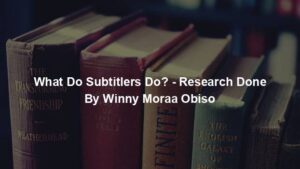What Is Music Transcription.mp3 transcript powered by Sonix—easily convert your audio to text with Sonix.
What Is Music Transcription.mp3 was automatically transcribed by Sonix with the latest audio-to-text algorithms. This transcript may contain errors. Sonix is the best audio automated transcription service in 2020. Our automated transcription algorithms works with many of the popular audio file formats.
The dubbing King software presents what is music transcription, a comprehensive guide. What is music transcription, background of transcription in general. When you hear the word transcription, depending on which industry you work in, then you might have a lot of different definitions for this word. Many people don't have the idea that there are many types of transcription out there, but I will mention just three, which are mainly used from time to time. There is transcription in the medical industry. There is transcription in the film industry. And last but not least, there is transcription in the music industry. In this article, I will talk about transcription in the music industry, but I will also define the other forms of transcriptions so that at least you can have a rough idea difference between medical film and music transcription. Transcription in the medical industry is part of the health sector that deals with rendering and editing, doctor dictated reports, procedures and notes in an electronic format to create script files. Transcription in the film industry is strictly known as the art of converting audio or video files into written text. And it can be in different formats. You can have them in a text format, word, document notes, saw whichever form of text you might be interested in. With that out of the way, we will delve deeper into the music form of transcription to understand it further and how it really works. Music transcription is defined as the art of exact note for note rendition of a piece of music written for one instrument and played on another.
For example, notes written for a guitar can have a rendition and end up being played on a piano. Normally, note for note transcriptions are usually rare because depending on what a speaker had said, if there were speech pauses, then the context is lost. What is exactly does music transcription involve? More often than not, music transcription is the kind that seeks to keep the character and context of the original while making some enhancement accommodations to support the capabilities and limitations of the instrument upon which the music will be accompanied with wireless rendition may still be called a transcription. It is more accurately an arrangement. Certain parts of the music have been arranged to work better on the non-native instrument. Just like the word states, an arrangement is when different parts of the music are arranged to work perfectly well with an instrument that was not intended for it. You note that the style and approach used in an arrangement, depending on the genre of music being arranged in the classical idiom, it is considered arrogant and very rude to try, fix or rewrite the music of brilliant composers such as Barkhor, Mozart, with such a kind of music. The best thing to do is to employ adaptation that has the least tore close to no alteration as possible in order not to change the feel of the music completely in pop music.
However, it would be okay or even preferable to stylize yet another version of yesterday here. It would be expected that the arranger may rework chords, add notes and melodies and change the form. In the pop music scene, one of the popular music that has been transcribed using the reorganizing and rewriting ways while steadily rising to the realm of artists, the big band jazz style, where the skill and imagination of the transcriptionist are central to the success of the resulting transcription. These versions are often more technically demanding than the original and blur the line between transcription and composition. In the classical world, Ravel's famous arrangement of pictures at an exhibition from a piano solo to an orchestral piece shows great imagination and creativity and is also a good example of the art of transcription. In the classical world of music, where guitars are concerned, transcriptions and arrangement systems are really used in all the times because of how the guitar keys are set. They can be transcribed into another instrument without a lot of hassle to go. Veha was famous for his transcriptions slash arrangements, as were Tarrega Abet and others. These transcriptions intended to keep the character of the composer's original composition while adapting the music to the guitar's idiosyncrasies. You can see this being illustrated in the music of J. S Bach. Never once did he write any note for the instrument. Yet we still hear amazing and wonderful transcription that he plays on his guitar.
The art of transcription in music always comes mostly from the choices made during adaptation to the new instrument. In this case, being a guitar, the Tooley Fog catalog is one of the largest catalog filled up with transcription and arrangements which were taken from orchestra performances. And in very rare instances, you would get one or two from piano works in such cases. It's usually impossible to do literal or close to literal transcriptions because they usually need a lot of changes and alterations for that kind of music to be effective on the guitar. From the tone color of the instrument to the chord voicing texture and most of all the range of the instrument, we can have a rough idea of why it would be impossible. These are too many parameters to perfect. What are the parameters in music transcription? Range. If you understood what the range of the guitar is and what it does in music, you would understand how hard it usually is to transcribe music from a piano, works to fit in a guitar perfectly. This instrument has a roughly three octave range. If you compare that number of range to that of a piano or an orchestra, then you know that it is a huge reduction usually for this to even work and be as perfect as expected. There has to be some compression of ranges, possibly a key change and most times a bouncing of octaves to voice the music effectively on the guitar.
Cord voicing musicians and sound engineers know that the tuning of the guitar usually makes certain types of cord voicing common to those of the piano and difficult, if not impossible for those of other instruments. Depending on the instrument that you would want to create a transcription for using the guitar might end up being hard and impossible to come up with a perfect rendition of the native instrument. These voicings will have to be modified to work on the guitar. Tone, color, the tonal color is one of the most important factors that must be considered during music transcriptions, and the reason I say this is that tonal variations may completely all to the range in which certain music has certain ranges of the guitar can be too muddy or too bright for certain melodies and can obscurely intended musical effect of the original. These sections will often need to be revoiced in a transcription. Certain music that takes advantage of an instrument's tone color may not work well enough on the guitar. For example, show Pann is beautiful on the piano, but the tonal character of the writing is so piano specific that it doesn't come off well in transcription to the guitar or other instruments. Texture orchestra music takes advantage of the different timbers of its instruments to create interest and depth. When one removes these different timbers and reduces the number of instruments to a few or even a single instrument, things that work well because of this timber, all variation can become repetitive and sometimes boring.
In certain instances, arrangers will remove sections that repeat with different timbers in the orchestra score when arranging for another instrument to avoid having the piece become monotonous. Reductions reduction is a new term that you might not understand. So I will expound on it when an orchestra piece undergoes an arrangement from a single instrument. Compared to all the instruments used for the original piece, it is then called an orchestra reduction. This means that the number of instruments on the original has been reduced to a certain number and thus reducing the ratios in terms of sheer numbers of instruments make it necessary to cut out large numbers of notes while still keeping as much of the essence of the original as possible. You might wonder why all this is termed as the art of transcription. Anything that includes the imagination, knowledge, skill and creativity of the person doing the arranging or the transcription is referred to as an art. And that is why it is known as the art of transcription. The imagination, knowledge and skill of the arrange a slash transcriber in manipulating these parameters are collectively known as the art of transcription. Always remember that the parameters that should be considered before a music transcription is done now reductions, tonal color, cord voicing and the range compatibility of the native instrument to the target instrument.
Automatically convert your audio files to text with Sonix. Sonix is the best online, automated transcription service.
Sonix uses cutting-edge artificial intelligence to convert your mp3 files to text.
Create and share better audio content with Sonix. Automated transcription can quickly transcribe your skype calls. All of your remote meetings will be better indexed with a Sonix transcript. Create better transcripts with online automated transcription. Do you have a podcast? Here's how to automatically transcribe your podcasts with Sonix. Sonix has the world's best audio transcription platform with features focused on collaboration. Are you a radio station? Better transcribe your radio shows with Sonix. Get the most out of your audio content with Sonix. Are you a podcaster looking for automated transcription? Sonix can help you better transcribe your podcast episodes.
Sonix uses cutting-edge artificial intelligence to convert your mp3 files to text.
Sonix is the best online audio transcription software in 2020—it’s fast, easy, and affordable.
If you are looking for a great way to convert your audio to text, try Sonix today.
Other Podcasts

How to Prepare a Film And Reels For Sound Editing – Research Done By Everline Moragwa Achira
Listen Now »


